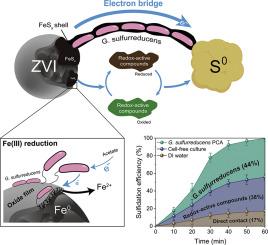Fast and Eco-friendly Sulfidation of Zero-Valent Iron Using Elemental Sulfur and Geobacter Sulfurreducens for Groundwater Remediation
IF 12.4
1区 环境科学与生态学
Q1 ENGINEERING, ENVIRONMENTAL
引用次数: 0
Abstract
Sulfidated zero-valent iron (S-ZVI) with high electron selectivity and reactivity toward contaminants is a promising reagent for groundwater remediation. However, the widely-used chemical and mechanical sulfidation methods to prepare S-ZVI are often chemical- or energy-intensive. Biogenic sulfidation method relying on sulfate-reducing bacteria (SRB) are considered as green methods, yet are time-consuming and may release toxic and odorous hydrogen sulfide gas. Instead, elemental sulfur (S0) as sulfur precursor may avoid prolonged preparation time and hydrogen sulfide emission. However, elemental sulfur is difficult to be utilized by SRB so as to hinder the production rate of S-ZVI. In this study, therefore, we proposed a novel biogenic sulfidation method using Geobacter sulfurreducens (PCA) to achieve fast, low-cost and eco-friendly S-ZVI preparation with insoluble S0 and Fe0 powders. The results showed that the successful sulfidation of ZVI using PCA strains and S0 without the addition of organic carbon was achieved within 2 hours, 13 times faster than SRB mediated sulfidation. The rate of hexavalent chromium removal by the PCA-synthesized S-ZVI was 68% higher than that by SRB-synthesized S-ZVI. The fast sulfidation proceeded via the reductive dissolution of iron oxide passivation layer on ZVI by PCA and the enhanced electron transfer between ZVI and S0 mediated by conductive PCA cells. The PCA-mediated sulfidation minimized the potential secondary pollution associated hydrogen sulfide and chemical consumption for the S-ZVI preparation. This study demonstrated a fast, chemical-saving and eco-friendly approach for S-ZVI preparation, which could be an ideal solution for groundwater remediation.

单质硫和硫还原菌在地下水修复中的快速环保硫化零价铁研究
硫化零价铁(S-ZVI)具有较高的电子选择性和对污染物的反应性,是一种很有前途的地下水修复试剂。然而,广泛使用的化学和机械硫化方法来制备S-ZVI往往是化学或能源密集型的。依靠硫酸盐还原菌(SRB)的生物硫化法被认为是绿色环保的方法,但耗时长,且可能释放出有毒、恶臭的硫化氢气体。相反,单质硫(S0)作为硫前驱体可以避免延长制备时间和硫化氢排放。但是单质硫很难被SRB利用,阻碍了S-ZVI的生产速度。因此,在本研究中,我们提出了一种新的生物硫化方法,利用硫还原Geobacter sulphreducens (PCA),以不溶性的S0和Fe0粉末快速、低成本和环保地制备S-ZVI。结果表明,在不添加有机碳的情况下,PCA菌株和S0在2小时内成功地硫化ZVI,比SRB介导的硫化快13倍。pca合成的S-ZVI对六价铬的去除率比srb合成的S-ZVI高68%。通过PCA对ZVI表面氧化铁钝化层的还原性溶解和导电PCA细胞介导的ZVI与S0之间的电子转移增强,实现了快速硫化。在制备S-ZVI的过程中,pca介导的硫化将与硫化氢相关的潜在二次污染和化学品消耗降至最低。本研究展示了一种快速、节省化学物质和环保的S-ZVI制备方法,它可能是地下水修复的理想解决方案。
本文章由计算机程序翻译,如有差异,请以英文原文为准。
求助全文
约1分钟内获得全文
求助全文
来源期刊

Water Research
环境科学-工程:环境
CiteScore
20.80
自引率
9.40%
发文量
1307
审稿时长
38 days
期刊介绍:
Water Research, along with its open access companion journal Water Research X, serves as a platform for publishing original research papers covering various aspects of the science and technology related to the anthropogenic water cycle, water quality, and its management worldwide. The audience targeted by the journal comprises biologists, chemical engineers, chemists, civil engineers, environmental engineers, limnologists, and microbiologists. The scope of the journal include:
•Treatment processes for water and wastewaters (municipal, agricultural, industrial, and on-site treatment), including resource recovery and residuals management;
•Urban hydrology including sewer systems, stormwater management, and green infrastructure;
•Drinking water treatment and distribution;
•Potable and non-potable water reuse;
•Sanitation, public health, and risk assessment;
•Anaerobic digestion, solid and hazardous waste management, including source characterization and the effects and control of leachates and gaseous emissions;
•Contaminants (chemical, microbial, anthropogenic particles such as nanoparticles or microplastics) and related water quality sensing, monitoring, fate, and assessment;
•Anthropogenic impacts on inland, tidal, coastal and urban waters, focusing on surface and ground waters, and point and non-point sources of pollution;
•Environmental restoration, linked to surface water, groundwater and groundwater remediation;
•Analysis of the interfaces between sediments and water, and between water and atmosphere, focusing specifically on anthropogenic impacts;
•Mathematical modelling, systems analysis, machine learning, and beneficial use of big data related to the anthropogenic water cycle;
•Socio-economic, policy, and regulations studies.
 求助内容:
求助内容: 应助结果提醒方式:
应助结果提醒方式:


